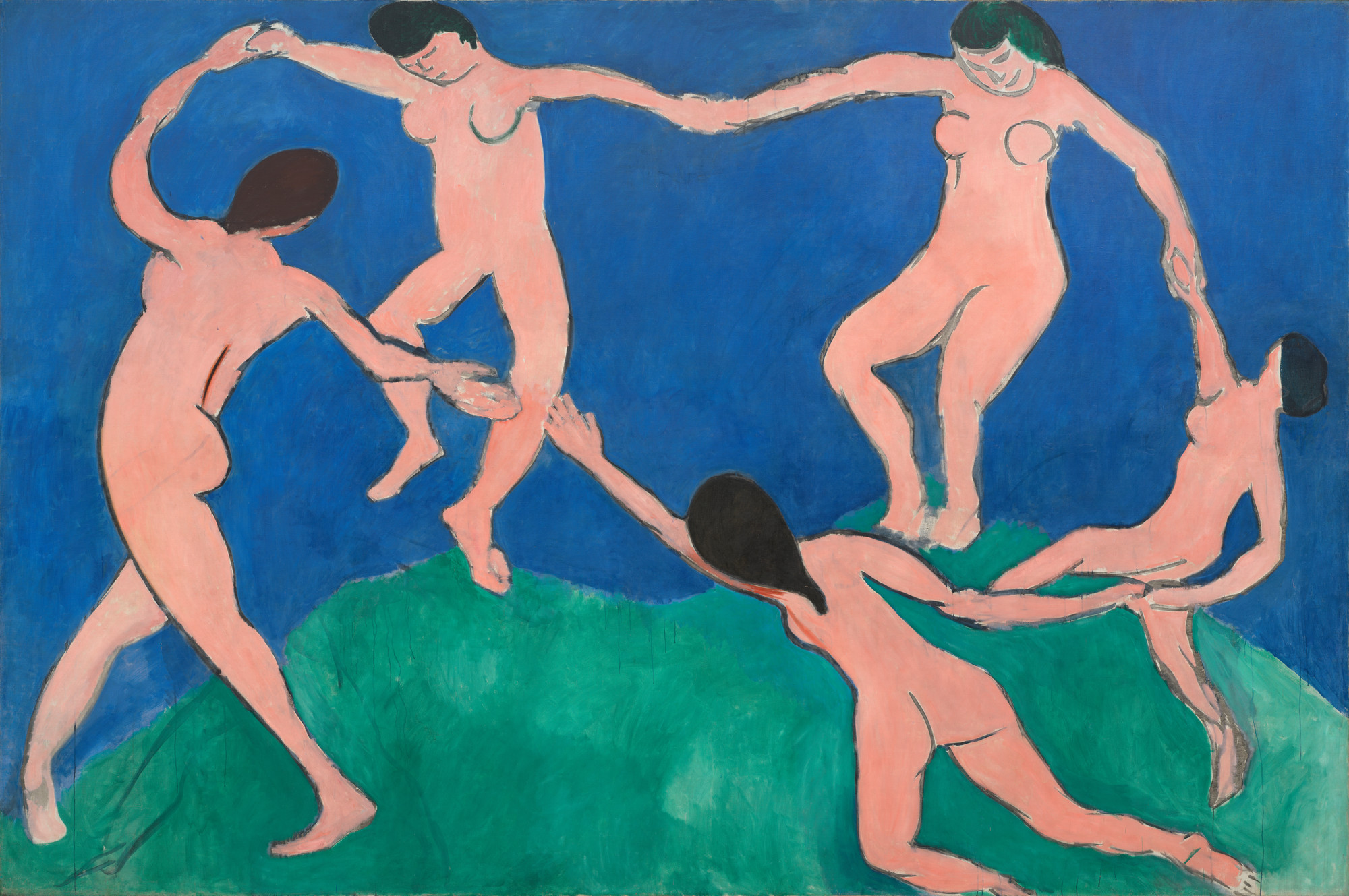Narrator: The French artist Henri Matisse painted Dance (First Version) in 1909 as a study for a mural by the same name. He used oil paint on canvas. The work measures about eight-and-a-half feet high and 13 feet wide. In metric units, it is 260 centimeters high and 390 centimeters wide.
This enormous painting shows five nude female figures with pale peach-pink skin and dark hair. Features, such as faces, buttocks, and breasts, are suggested only by minimal watery black outlines. Visibly loose brushstrokes, dripping lines of paint, and glimpses of raw canvas convey an element of quickness and improvisation.
The figures dance in a circle with most of their hands joined, leaping, stepping, and hopping on an emerald green landscape beneath a royal blue sky. The dancers’ bodies are barely contained by the four edges of the canvas and their poses convey a sense of rhythm, movement, and momentum.
About a third of the way up the canvas, land meets sky along a wavy horizon line suggesting a hilly landscape. The hills and sky are painted with large areas of solid color, making the painting appear flat. Matisse has also removed a sense of depth so that the dancers appear as two-dimensional figures atop a blue and green background.
Now let’s explore the figures in more detail moving clockwise around the painting, starting at the left side.
Positioned at nine o’clock, our first figure has her back toward us with a slight swivel in the hips. She crosses her right leg over the other, making an upside-down V-shape with her legs. Her left leg extends behind her so we see her buttock in profile. She plants the ball of her foot into the ground and lifts the heel. The right leg curves as she stands on the toes and outer edge of her foot.
While her legs twist to the left, her hips and torso swivel in the opposite direction. The dancer stretches her spine tall, her torso arching backward slightly as her chest and right arm tilt toward the inside of the dancers’ circle. Her right arm, with its oven-mitt-shaped hand, stretches down. Her left arm arcs up toward the top of the painting where she clasps the hand of a second figure in the 11 o’clock position.
This next figure faces forward in mid-hop, the top of her dark hair skimming the upper edge of the canvas. She bends her right leg at the knee, her foot hovering a few inches off the ground. She balances her weight on the ball of her left foot and stretches her arms out to her sides. Her chin is tucked into her chest and her eyes close softly into two curved lines.
Let’s continue moving clockwise around the ring of dancers. The third figure, positioned at 1 o’clock, faces us. She has green-black hair that touches the top edge of the canvas. Her nose, mouth, and eyes are painted with a few short and minimal black brushstrokes. She plants both feet on the ground, but her knees bend slightly—as if preparing for another springy step. Both arms arc downward. Her left hand holds the hand of a fourth figure on the far right side of the painting.
This fourth dancer, positioned at 3 o’clock, is smaller than the others. She leans back, towards the right edge of the canvas, seemingly off balance with her left foot in the air while her head tilts up to the sky. Her body is in profile, and she does not have facial features. Her right arm extends up while her left arm arcs down to grasp the hand of our fifth and final dancer positioned at 5 o’clock.
This dancer appears almost to be falling onto her side. It’s as if the group’s momentum loosened her grip on the hand of the first dancer to her left. In an attempt to close this gap in the dancers’ circle, her body sways diagonally across the bottom of the canvas. Imagine lunging to your left. Your left leg bends at the knee and your right leg stretches out behind you, foot dangling in the air.
Matisse’s approach to painting was partly the result of innovations in photography, which had become widespread by the late 1800s. In 1909, the year he made this painting, Matisse observed, “The painter no longer has to preoccupy himself with details. The photograph is there to render the multitude of details a hundred times better and more quickly.” Freed from the constraints of faithfully depicting reality, Matisse opted for an expressive approach to painting that embraced stylized lines, colors, and forms.
